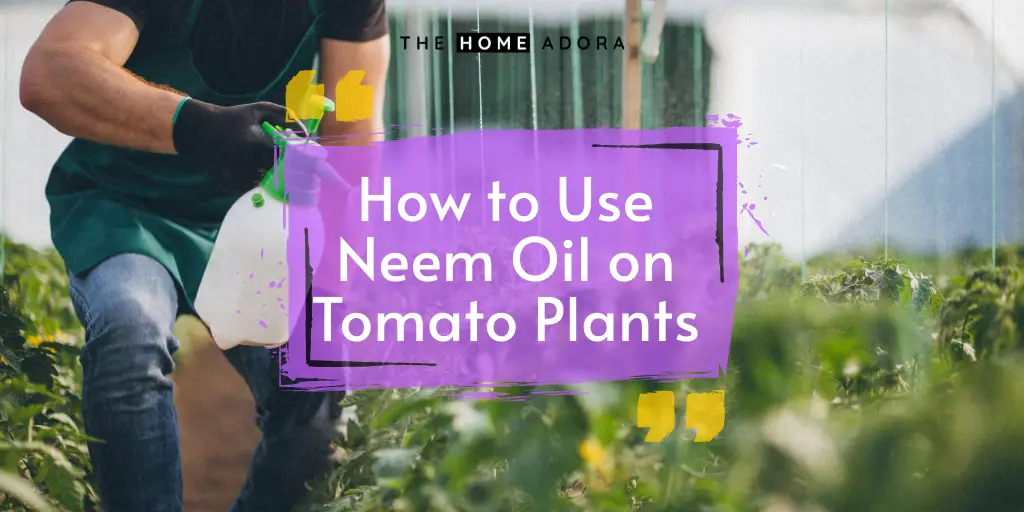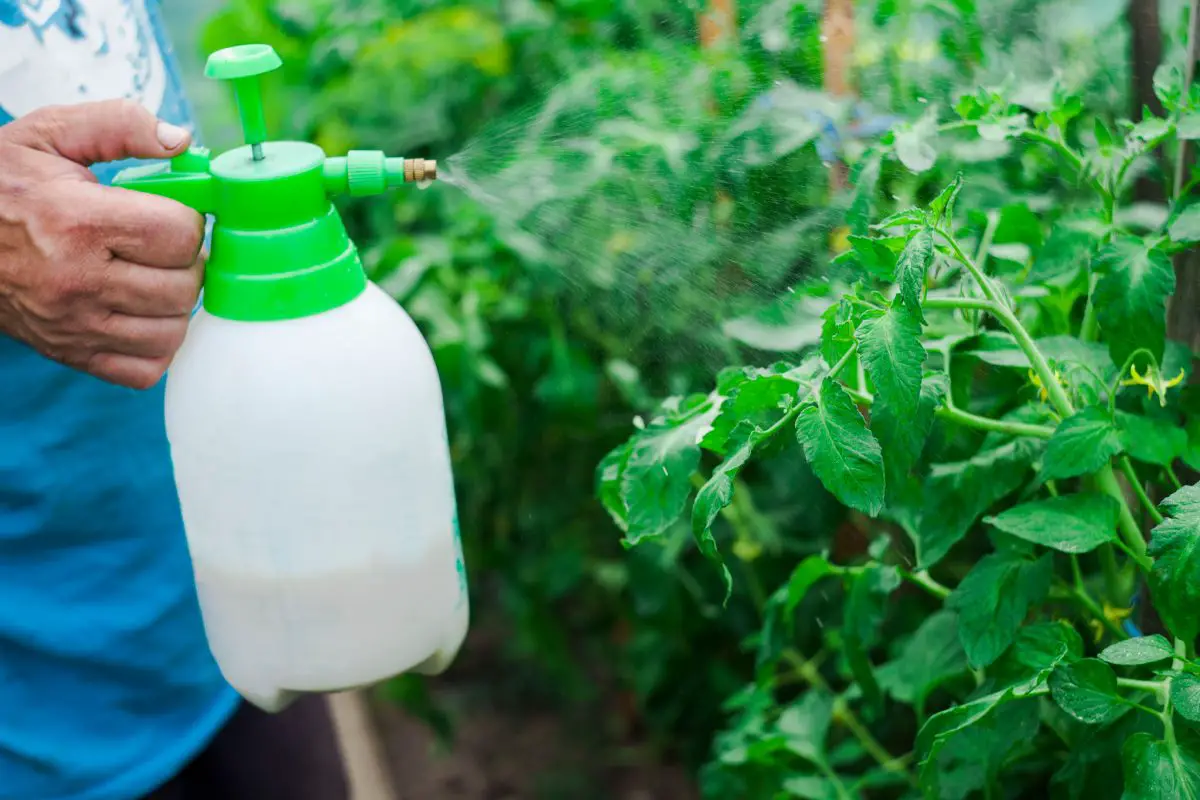Neem oil is a natural product made from the seeds of the neem tree. It has many uses, including as an insecticide and fungicide. It is also a popular choice for organic gardening.

Neem oil could be just what your tomato plants need to thrive. This organic pesticide is an effective and safe choice for many gardeners worldwide to manage pests (a gardener’s worst nightmare)!
Let’s take a closer look at what neem oil is and how you can use it on your tomato plants.
Neem Oil: What Is It?
Neem oil, as well known as margosa oil, is a vegetable oil extracted from the fruits and seeds of the neem (Azadirachta indica) and a tomato gardener’s best friend, a tree native to the Indian subcontinent that has spread to numerous other tropical areas.
Azadirachtin is the most important ingredient for gardeners because it can resist or kill pests. Gardeners are using neem oil as a pesticide to keep their growing plants safe from predators.
The Advantages of Using Neem Oil on Tomato Plants
Because neem oil is an effective natural pesticide, using it on your tomato plants can be extremely beneficial.
It is mainly used as a spray to prevent pests and protect growing plants’ foliage. Neem oil is absorbed by plants after being sprayed on them.
When insects like aphids or whiteflies consume the plant, they absorb neem oil. The neem oil is then able to:
- Stop insects from feeding
- Sometimes they struggle to breathe.
- Prevent larvae from maturing
- Reduce mate-seeking behavior
Is It Safe to Use Neem Oil on Tomato Plants?
It’s natural to wonder if using neem oil on tomato plants is safe, Neem oil is considered safe almost everywhere. Consider the long-term effects of any treatment on the edible plant fruits when applying it to your plants.
Neem oil is more than just a pesticide; it also has antifungal properties that aid plants in combating root rot, leaf spot, mildew, and tomato plant leaves curling. Neem oil also contains fatty acids and micronutrients, which aid in plant growth and health.
In small amounts, neem oil is not toxic or harmful to humans or animals such as pets and birds.
However, because it is mildly harmful to aquatic animals, neem oil is prohibited in the United Kingdom and Canada. As a result, if you live in one of these countries, you will need to find a safe alternative pesticide.
How to Use Neem Oil on Tomato Plants
Because neem oil can be harmful to certain plants, it is critical to test this pesticide first.

To 1 quart of warm water, mix 1 teaspoon neem oil and 1/3 teaspoon dish soap. Wait 24 hours after spraying a small area of soil around your plant. Check to see if any of the plants were harmed by the spray; if not, it should be safe to use as a pesticide.
Tomato plants do not usually respond negatively to neem oil. A neem oil soak is an extremely effective way to protect your tomato plants from pests.
To create your soak, combine 1 teaspoon cold-pressed raw neem oil, 1 quart water, and 1 teaspoon liquid dish soap. Allow the mixture to soak into the soil around your tomato plants.
Your tomato plants will then absorb the neem oil through their roots, where it will remain for up to 22 days. Repeat every 3 weeks to keep the neem oil working.
Alternatively, 1 quart of water, 1 teaspoon of liquid dish soap, and 1 teaspoon of clarified hydrophobic neem oil can be combined to make a foliar spray.
Fill a spray bottle halfway with this mixture and thoroughly spray your tomato plants, including underneath each leaf.
When you first apply, make sure to do this every other day for the first 14 days. This ensures that any prior infestation is eradicated. Following that, you can use the foliar spray once every 14 days.
Effective Neem Oil Alternative
As previously stated, you cannot use neem oil if you live in the United Kingdom or Canada due to the presence of Azadirachtin. It is prohibited due to the potential for harm to fish and other aquatic animals.
Olive oil is an alternative that you most likely already have in your kitchen. Despite the fact that olive oil lacks the compound Azadirachtin found in neem oil, it has a beneficial effect on pest control. Olive oil suffocates pests, allowing them to be removed safely and without harming the environment, your plants, or yourself.
To use Olive Oil, One cup of olive oil and one spoonful of dishwashing soap can be used. Then add a cup of water and 1 teaspoon of this combination. Fill a spray bottle with the mixture, then liberally mist your tomato plants.
Where Can I Purchase Neem Oil?
If you live in the United States, you can easily buy neem oil in bulk from sites like Amazon.
Zatura Store and Greenive Store both sell 100% pure cold-pressed neem oil in sizes ranging from 8-16oz. Because this is a large amount, keep it out of the reach of children and pets, as larger quantities of neem oil may be toxic.
If you live outside of the United Kingdom or Canada, you can use neem oil as a highly effective pesticide on your tomato plants.
Read More: How to Prepare Soil for Organic Gardening
Using Neem OIL to Prevent Powdery Mildew & Blight on Tomatoes
Frequently Asked Questions (FAQs)
Can I Spray Neem Oil directly onto Plants?
Yes, you can spray Neem Oil directly into plants leave. Apply your neem oil mixture to a small section of your plants using a foliar spray bottle. Allow twenty-four hours. If the mixture causes no damage, thoroughly mist your indoor and outdoor plants, spraying directly onto plant leaves.
What plants do not tolerate neem oil?
Basil, caraway, cilantro, dill, marjoram, oregano, parsley, and thyme should not be sprayed with neem oil. Spraying neem oil on plants with delicate or wispy leaves, such as arugula, lettuce, peas, and spinach, should be done with caution, as this can result in foliage burns.
Conclusion
Because neem oil is a natural resource, it is considered safe to use on your plants and should not harm you, your plants, or the animals in your garden.
Neem oil is a tomato gardener’s best friend and a low-cost but effective tool for managing unwanted garden pests.
If you did learn how to use neem oil on tomato plants from this article, please share it with your friends on Facebook, Instagram, and Pinterest.
